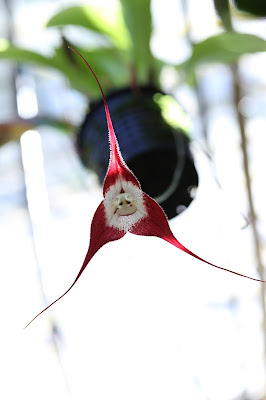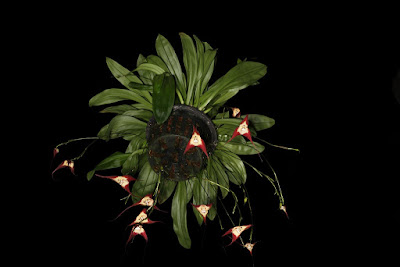Dracula tubeana is native to Ecuador. These plants are found in the Pichincha Province in cool, humid, rich in orchids rainforests, at an altitude of about 2000 m. This species is rare in nature and in crops...
Dracula tubeana also called as The Tubed-Shaped Dracula, Dracula tarantula, Masdevallia tarantula, Masdevallia tubeana, is a species of the genus Dracula. This species was described by Carlyle August Luer in 1978.
IDENTIFY DRACULA TUBEANA
Dracula tubeana is native to Ecuador. These plants are found in the Pichincha Province in cool, humid, rich in orchids rainforests, at an altitude of about 2000 m. This species is rare in nature and in crops, and nowadays their gatherings were made only near the old road between Quito and San Domingo and in wet forests above Chiriboga.
It is a cold growing, small sized epiphytic orchid, which reaching a height of 25 cm, with slender, erect, 2-4 cm long ramicauls enveloped basally by 2 to 3 loose, tubular sheaths and carrying a single, apical, erect, thinly coriaceous, carinate, elliptical, acute, gradually narrowing below into the conduplicate, indistinct, petiolate base, 15-21 cm long and 2.5-4.0 cm wide leaf.
The Tubed-Shaped Dracula blooms in the winter, spring and fall on a slender, ascending to descending, 11 to 18 cm long, successively single, few flowered inflorescence arising from low on the ramicaul and carrying a tubular floral bract. The flowers are 12.5-20 cm in diameter. The outer whorls are light yellow and above the center are red-purple or red-brown, mosaic, and their tops are elongated to form long, dark purple petioles. The inner surface is quite densely covered with short hairs. The inner coat flakes are ivory-colored and have orange and brown spots. The lip is white and the pale yellow light.
DRACULA TUBEANA CARE AND CULTURE
Cultural information should only be used as a guide, and should be to be adapted to suit you. Your physical location; where you grow your plants, how much time you have to devote to their care, and many other factors, will need to be taken into account. Only then can you decide on the cultural methods that best suit you and your plants.
Light:
Dracula tubeana needs a light level of 12000-18000 lux. The conditions should be shady, light filtered or scattered, and the plants should never be exposed to direct sunlight. Strong air movement should be ensured all the time. If the plants do not bloom, you can gradually introduce a slightly higher level of light, but care should be taken that the leaves do not burn.
Temperature:
Throughout the year the average day temperature is 24-27 ° C, the night 12-13 ° C, and the daily difference is 11-16 ° C.
Humidity:
The Tubed-Shaped Dracula needs the average humidity of 75-80% for most of the year, but falls to 60-65% in the 3 winter months.
Substrate, growing media:
Dracula tubeana should be grown mounted on rootstocks or in hanging baskets or mesh pots. When mounted on rootstocks, it is necessary to constantly provide high humidity and watering in summer at least once a day, and in case of hot and dry weather, it may be necessary to water several times a day.
These plants are usually grown in hanging baskets lined with sphagnum and filled with a loose, fast-drying substrate containing chopped sphagnum or perlite to retain moisture and charcoal to prevent souring the substrate while at the same time relaxing it.
Repotting:
This species recommend annual repotting. You can use a substrate with only loosely packed sphagnum from New Zealand, but then the plants should be repotted every 9-12 months, especially if the water used is highly mineralized. When the sphagnum begins to decompose, the balance is dramatically disturbed in the content of trace elements, which can kill plants. However, whatever substrate is used, it should be repotted when it is decomposing, or when the plant grows out of the container.
Repotting is best done when new roots begin to grow. Then the plants are able to stabilize the most quickly. This is usually done at the end of winter or early spring, but it can be done in any period between autumn and spring, as long as it does not interfere with flowering.
Watering:
From spring to late autumn, the precipitation is moderate to heavy. In winter, however, it is much drier. Dracula tubeana should be constantly evenly moist throughout most of the year, but at the end of autumn the amount of water should be slightly reduced.
Fertilizer:
It is recommended to apply a 1/4-1/2 dose of orchid fertilizer weekly during the growing season. You can use a balanced fertilizer throughout the year, but also can use high-nitrogen fertilizer from spring to mid-summer, and then until the end of autumn, high phosphorus fertilizer.
Rest period:
Dracula tubeana need to be slightly less water, but they can never dry up completely. Fertilization should be reduced until spring, when watering increases.















COMMENTS